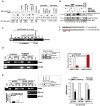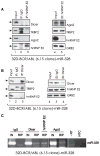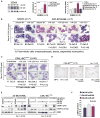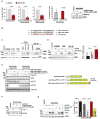miR-328 functions as an RNA decoy to modulate hnRNP E2 regulation of mRNA translation in leukemic blasts
- PMID: 20211135
- PMCID: PMC2924756
- DOI: 10.1016/j.cell.2010.01.007
miR-328 functions as an RNA decoy to modulate hnRNP E2 regulation of mRNA translation in leukemic blasts
Abstract
MicroRNAs and heterogeneous ribonucleoproteins (hnRNPs) are posttranscriptional gene regulators that bind mRNA in a sequence-specific manner. Here, we report that loss of miR-328 occurs in blast crisis chronic myelogenous leukemia (CML-BC) in a BCR/ABL dose- and kinase-dependent manner through the MAPK-hnRNP E2 pathway. Restoration of miR-328 expression rescues differentiation and impairs survival of leukemic blasts by simultaneously interacting with the translational regulator poly(rC)-binding protein hnRNP E2 and with the mRNA encoding the survival factor PIM1, respectively. The interaction with hnRNP E2 is independent of the microRNA's seed sequence and it leads to release of CEBPA mRNA from hnRNP E2-mediated translational inhibition. Altogether, these data reveal the dual ability of a microRNA to control cell fate both through base pairing with mRNA targets and through a decoy activity that interferes with the function of regulatory proteins.
(c) 2010 Elsevier Inc. All rights reserved.
Figures







Comment in
-
Preview. MicroRNAs: from decay to decoy.Cell. 2010 Mar 5;140(5):612-4. doi: 10.1016/j.cell.2010.02.020. Cell. 2010. PMID: 20211130
Similar articles
-
High levels of the BCR/ABL oncoprotein are required for the MAPK-hnRNP-E2 dependent suppression of C/EBPalpha-driven myeloid differentiation.Blood. 2007 Aug 1;110(3):994-1003. doi: 10.1182/blood-2007-03-078303. Epub 2007 May 2. Blood. 2007. PMID: 17475908 Free PMC article.
-
Identification of novel posttranscriptional targets of the BCR/ABL oncoprotein by ribonomics: requirement of E2F3 for BCR/ABL leukemogenesis.Blood. 2008 Jan 15;111(2):816-28. doi: 10.1182/blood-2007-05-090472. Epub 2007 Oct 9. Blood. 2008. PMID: 17925491 Free PMC article.
-
BCR-ABL suppresses C/EBPalpha expression through inhibitory action of hnRNP E2.Nat Genet. 2002 Jan;30(1):48-58. doi: 10.1038/ng791. Epub 2001 Dec 20. Nat Genet. 2002. PMID: 11753385
-
From mRNA metabolism to cancer therapy: chronic myelogenous leukemia shows the way.Clin Cancer Res. 2007 Mar 15;13(6):1638-42. doi: 10.1158/1078-0432.CCR-06-2320. Clin Cancer Res. 2007. PMID: 17363515 Review.
-
Control of mRNA translation and stability in haematopoietic cells: the function of hnRNPs K and E1/E2.Biol Cell. 2004 Aug;96(6):407-11. doi: 10.1016/j.biolcel.2004.03.010. Biol Cell. 2004. PMID: 15384226 Review.
Cited by
-
A glance at subgenomic flavivirus RNAs and microRNAs in flavivirus infections.Virol J. 2016 May 28;13:84. doi: 10.1186/s12985-016-0541-3. Virol J. 2016. PMID: 27233361 Free PMC article. Review.
-
MicroRNAs in Myeloid Hematological Malignancies.Curr Genomics. 2015 Oct;16(5):336-48. doi: 10.2174/138920291605150710122815. Curr Genomics. 2015. PMID: 27047254 Free PMC article.
-
MicroRNA-130a regulates cell malignancy by targeting RECK in chronic myeloid leukemia.Am J Transl Res. 2016 Feb 15;8(2):955-67. eCollection 2016. Am J Transl Res. 2016. PMID: 27158382 Free PMC article.
-
Pim kinase inhibition sensitizes FLT3-ITD acute myeloid leukemia cells to topoisomerase 2 inhibitors through increased DNA damage and oxidative stress.Oncotarget. 2016 Jul 26;7(30):48280-48295. doi: 10.18632/oncotarget.10209. Oncotarget. 2016. PMID: 27374090 Free PMC article.
-
microRNA-mediated regulation of innate immune response in rheumatic diseases.Arthritis Res Ther. 2013 Apr 9;15(2):210. doi: 10.1186/ar4194. Arthritis Res Ther. 2013. PMID: 23582400 Free PMC article. Review.
References
-
- Agirre X, Jimenez-Velasco A, San Jose-Eneriz E, Garate L, Bandres E, Cordeu L, Aparicio O, Saez B, Navarro G, Vilas-Zornoza A, et al. Down-regulation of hsa-miR-10a in chronic myeloid leukemia CD34+ cells increases USF2-mediated cell growth. Mol Cancer Res. 2008;6:1830–1840. - PubMed
-
- Brown V, Jin P, Ceman S, Darnell JC, O’Donnell WT, Tenenbaum SA, Jin X, Feng Y, Wilkinson KD, Keene JD, et al. Microarray identification of FMRP-associated brain mRNAs and altered mRNA translational profiles in fragile X syndrome. Cell. 2001;107:477–487. - PubMed
-
- Bueno MJ, Perez de Castro I, Gomez de Cedron M, Santos J, Calin GA, Cigudosa JC, Croce CM, Fernandez-Piqueras J, Malumbres M. Genetic and epigenetic silencing of microRNA-203 enhances ABL1 and BCR-ABL1 oncogene expression. Cancer Cell. 2008;13:496–506. - PubMed
-
- Carpenter B, MacKay C, Alnabulsi A, MacKay M, Telfer C, Melvin WT, Murray GI. The roles of heterogeneous nuclear ribonucleoproteins in tumour development and progression. Biochim Biophys Acta. 2006;1765:85–100. - PubMed
Publication types
MeSH terms
Substances
Grants and funding
LinkOut - more resources
Full Text Sources
Other Literature Sources
Medical
Molecular Biology Databases
Research Materials
Miscellaneous

